Scottish Fruit Pudding is generally part of a classic Scottish Breakfast, and yet it seems to be disappearing from plates across the country as we don’t see it as often when eating out, and generally only as a part of certain breakfast packs in some supermarkets.
We decided it was time to make our own homemade Scottish Fruit Pudding recipe so you’re not reliant on getting it from elsewhere.
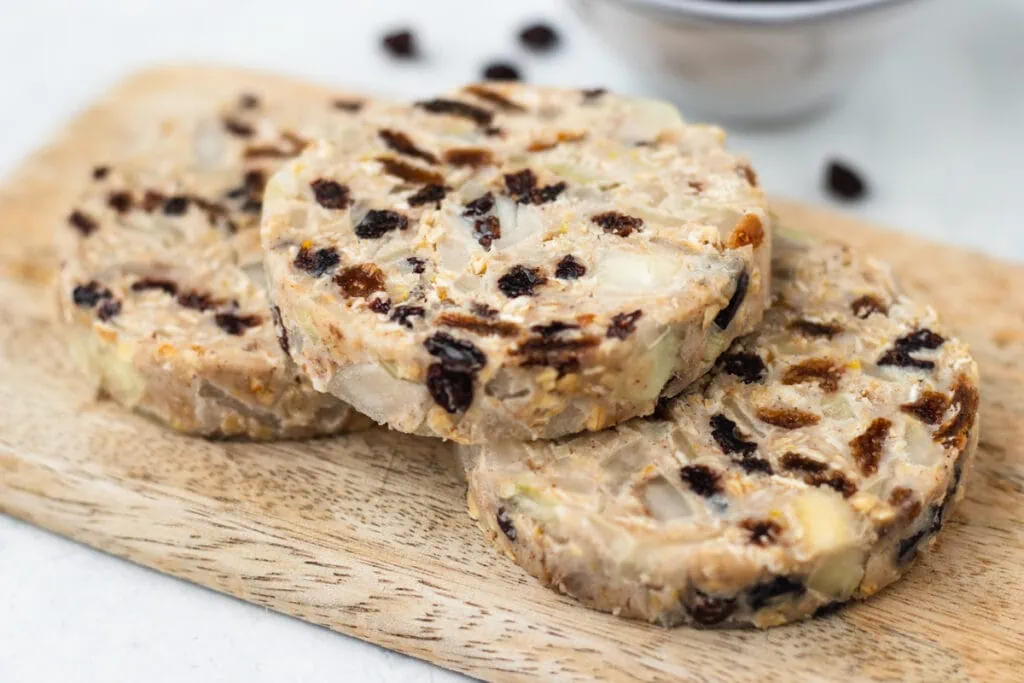
What is Scottish Fruit Pudding?
Scottish Fruit Pudding is a combination of oatmeal and beef suet, with dried fruit like raisins and currants, brown sugar, and spices like cinnamon. It’s generally formed into a sausage shape and sliced for frying in butter. The result is both savoury and sweet!
“Pudding” in the British Isles doesn’t always refer to what those not from there might think. There’s Black Pudding and White Pudding too. It’s said that the word “pudding” in this sense derives from the Latin word “botellus” which means sausage.
Technically, Haggis is also a type of pudding as it mixes offal and spices within a casing.
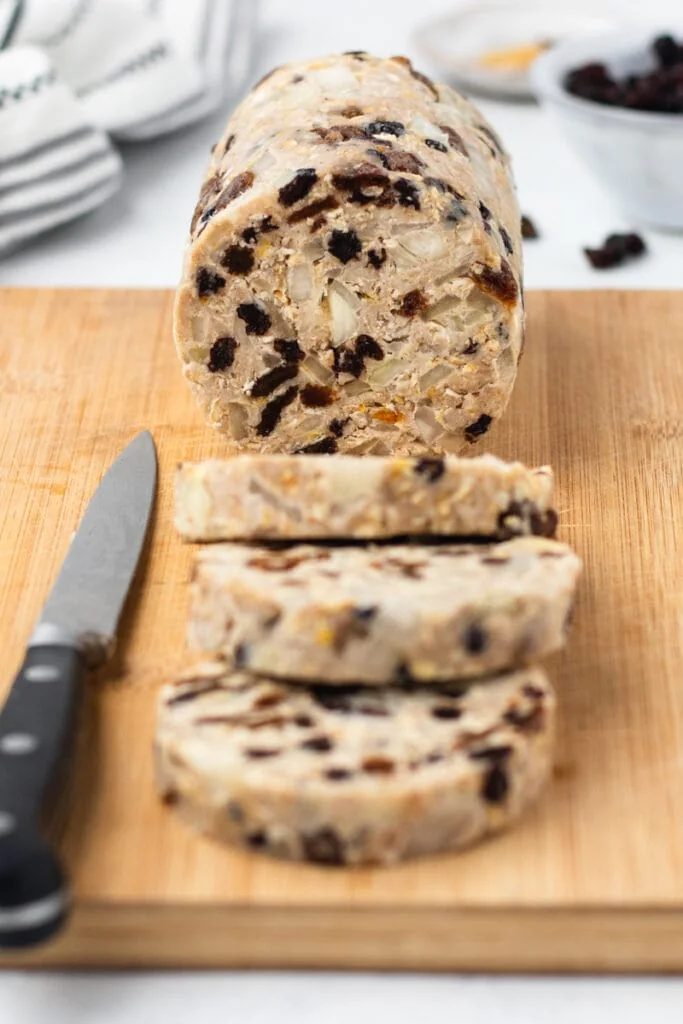
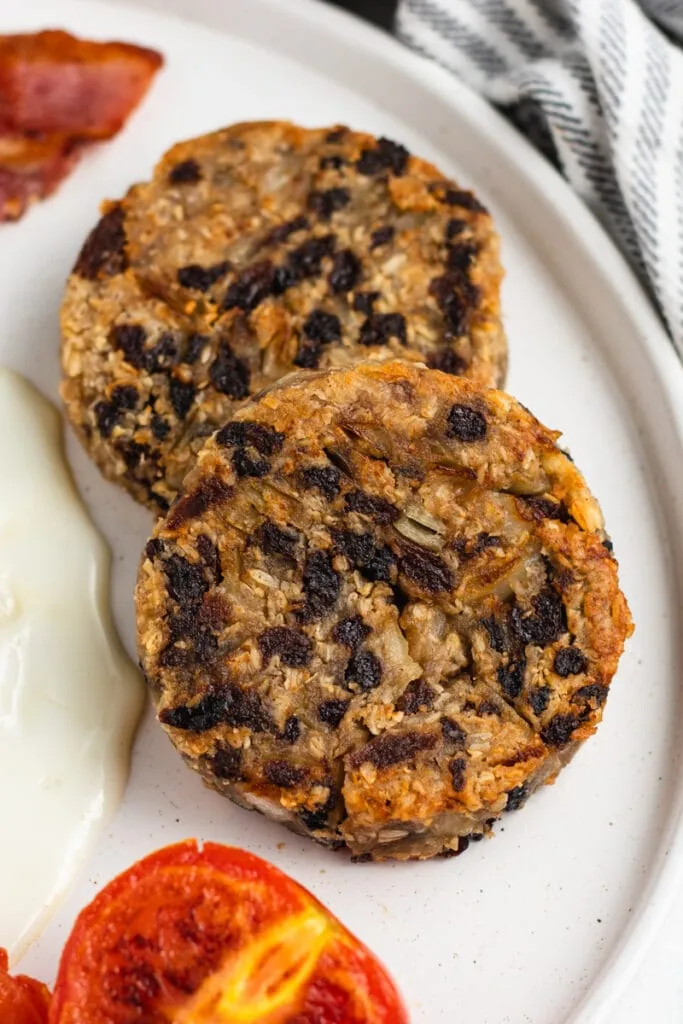
As we said above, Fruit Pudding mixes fruit and spices with oatmeal and suet. Here’s a rundown of the others:
Black Pudding: A type of blood sausage that originates in the United Kingdom and Ireland and was a way of using up as much of an animal as possible for food. It’s generally pork or beef blood mixed with pork or beef suet and some kind of cereal or rusk like oats or barley groats and seasoning like pennyroyal, marjoram, or thyme made into a sausage.
White Pudding: Also known as Mealy Pudding, White Pudding is similar to Black Pudding but without blood. It was a way to use up offal, although it could also be made “meat-free”. Medieval recipes included everything from liver, cream, egg, and rice or breadcrumbs to suet, cream, oatmeal, and eggs. Modern recipes generally combine suet, oatmeal or barley, breadcrumbs, and sometimes pork liver.
Scottish Fruit Pudding is similar to White Pudding, without the liver, but it also contains dried fruit and more spices like cinnamon.
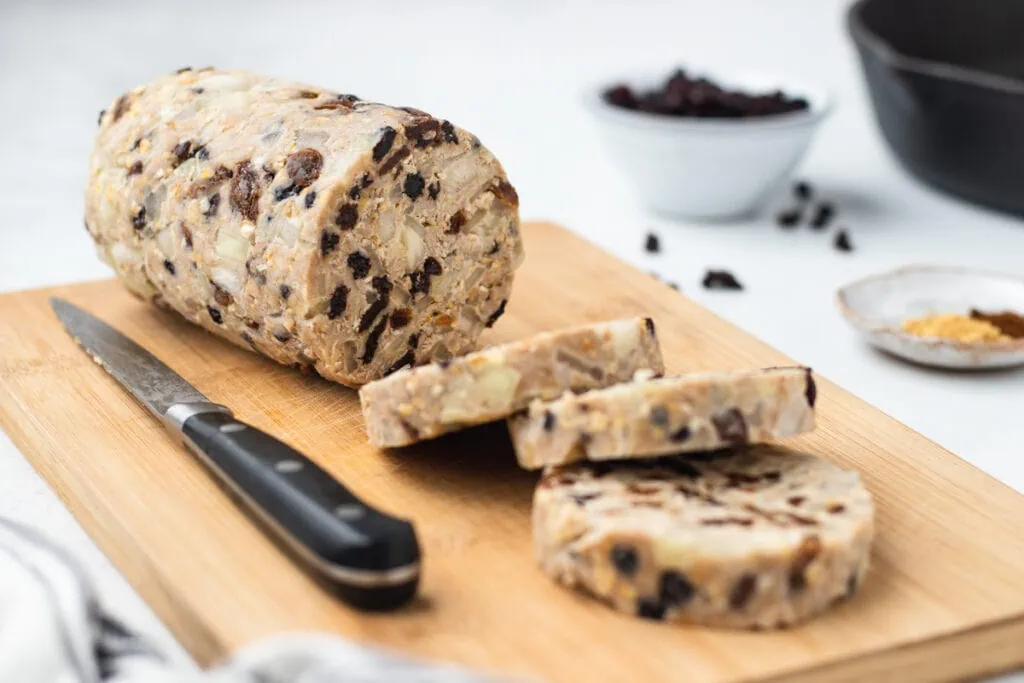
Why would you want to try Fruit Pudding?
Fruit Pudding is a tasty sweet/savoury combination to have on your breakfast plate, in contrast to all of the other savoury items. We’ve also seen it served with a more pared-down breakfast of eggs and bacon or even fancied up a bit with poached eggs and asparagus.
Many people enjoy Fruit Pudding because of the nostalgia surrounding having it in their childhood. We think it’s time to bring it back! Or at least, your own homemade version of it.
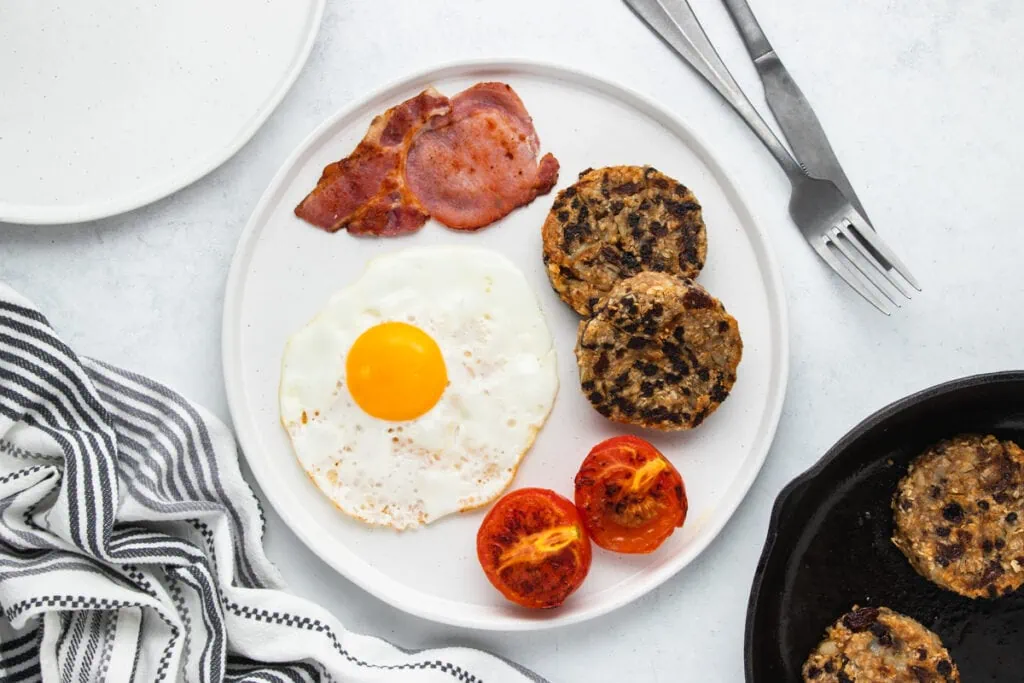
Is Fruit Pudding the same as Clootie Dumpling?
While frying a slice of Clootie Dumpling and adding it to your breakfast plate is popular, it’s not the same thing as Fruit Pudding.
Normally it is served freshly cooked with custard, but since it doesn’t have a particularly long shelf-life, any leftovers are often fried the next morning with breakfast too.
Fruit Pudding does have some similar spices and fruits in it, but it is generally a different colour thanks to the different mixture of ingredients, and it’s formed into a sausage shape before cooking for the first time in the pan rather than being cooked separately and re-frying like Clootie Dumpling would be.
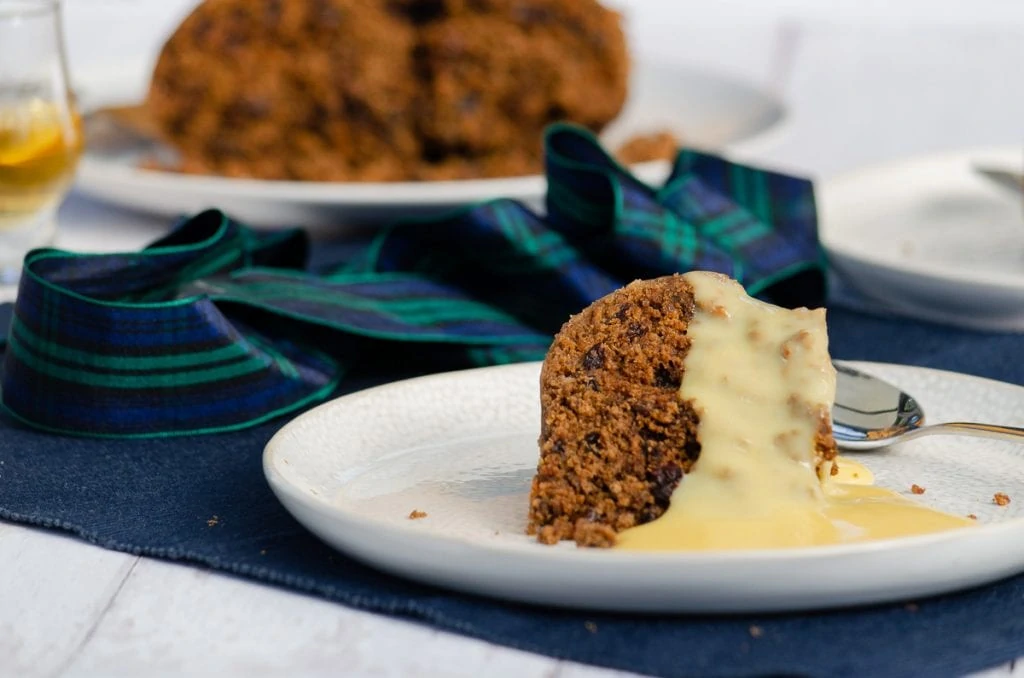
The History of Fruit Pudding
White Pudding or Mealy Pudding recipes are believed to have originated in Medieval times, and there are countless recipes and variations that can be attributed to that time and have evolved ever since.
Some of these include adding currants and spices like cinnamon, which is likely where Fruit Pudding originates from, as a slightly sweetened variation on white pudding.
Is this real Fruit Pudding?
Bought Fruit Pudding is made in a sausage casing which holds it together when it cooks. While the ingredients of our pudding are the same, we have found a way to make it without the sausage casing since most people don’t have the tools to make sausages in their own homes.
This recipe is much like our Lorne Sausage one, where you freeze the pudding in a sausage shape to enable you to be able to slice it, and that helps it stay together as it cooks as well.
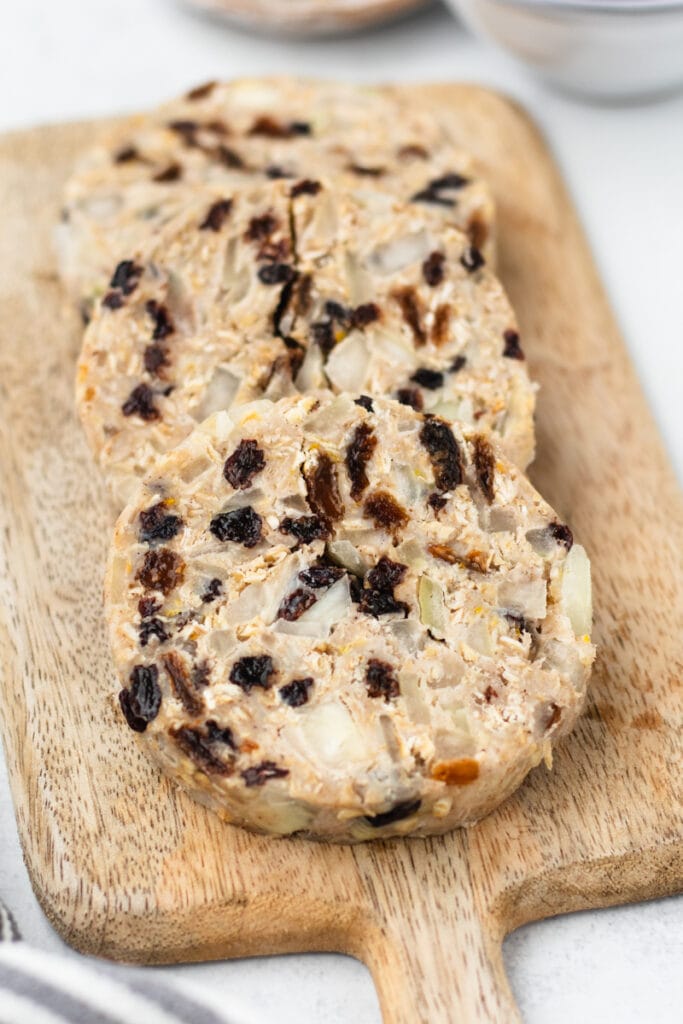
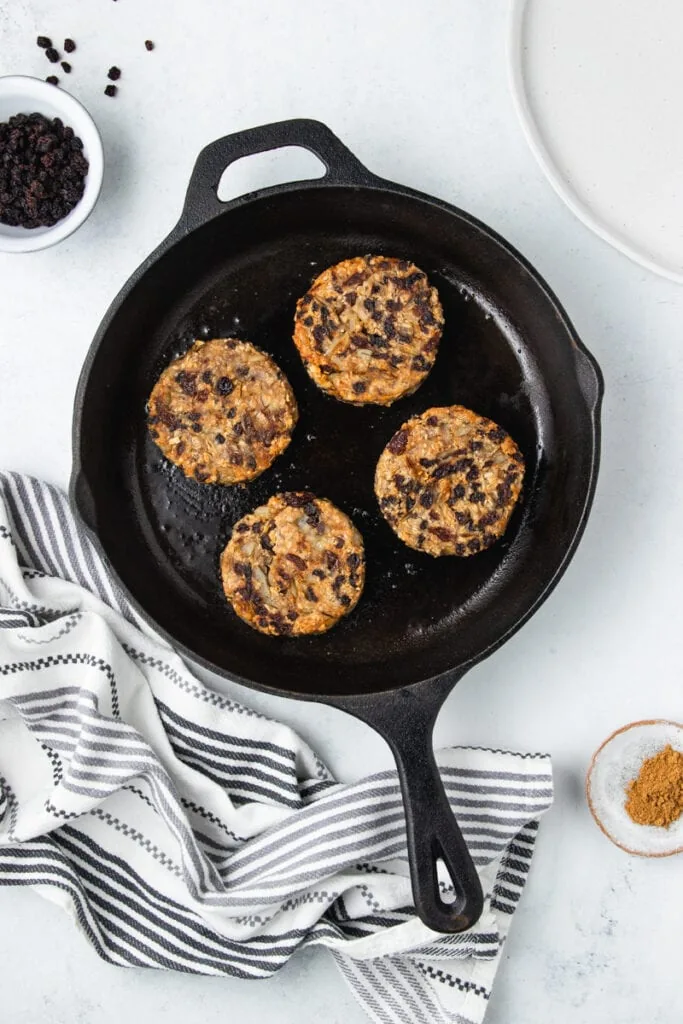
Things you’ll need to make Scottish Fruit Pudding
- Large Baking Tray
- Cling Film
- Frying Pan
Ingredients for Fruit Pudding
Yield: Approx. 30 slices. You can reduce the recipe if you want less, but it does freeze well, so you can just keep them in the freezer and take them out as needed. See below for details.
Prep time: 10 minutes
Cooking time: 22 minutes
Freezing time: 2 hours
- 400g/14oz beef suet
- 400g/14oz porridge oats (5 cups)
- 400g/14oz plain flour (3 1/3 cups)
- 1 tbsp brown sugar
- 3 large onions (finely chopped)
- 250g currants (1 ¼ cups)
- 250g sultanas (1 ¼ cups)
- 1 tbsp orange zest
- 1 tsp ground ginger
- 1 tsp cinnamon
- ½ tsp ground cloves
- 1 tsp allspice
- ½ tsp salt
Dried Fruit
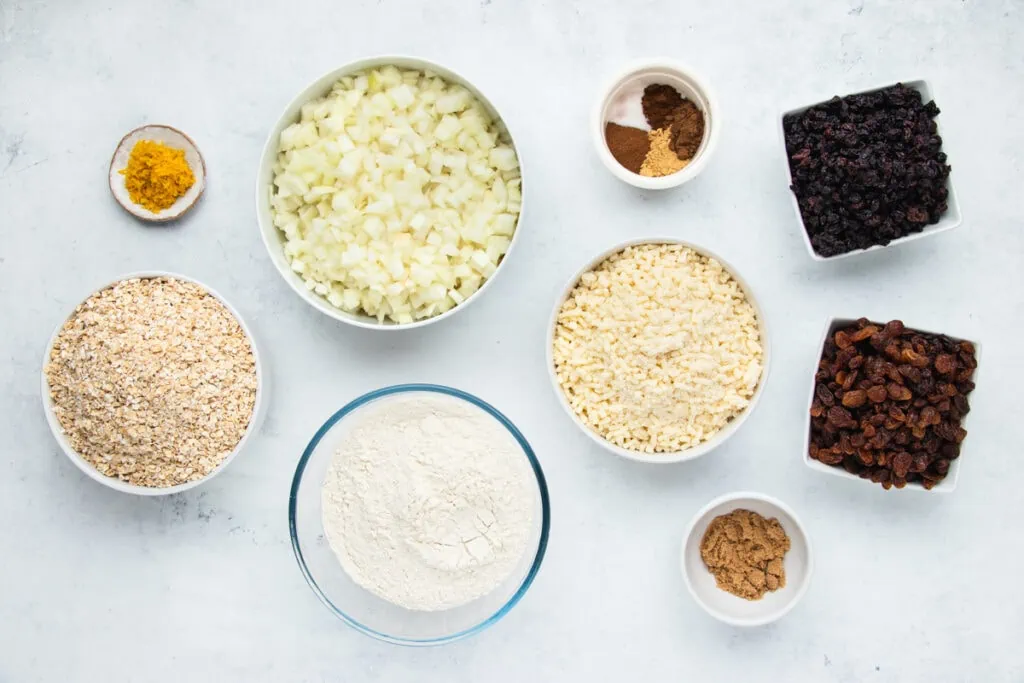
Our recipe uses a generous amount of dried fruit – sultanas and currants – so the pudding slices are fairly full of it. Feel free to reduce the amount if you prefer.
How to make Fruit Pudding – Step-by-step method
Preheat the oven to 180C. Spread the oats out on a large baking tray and toast in the oven for 12 minutes.
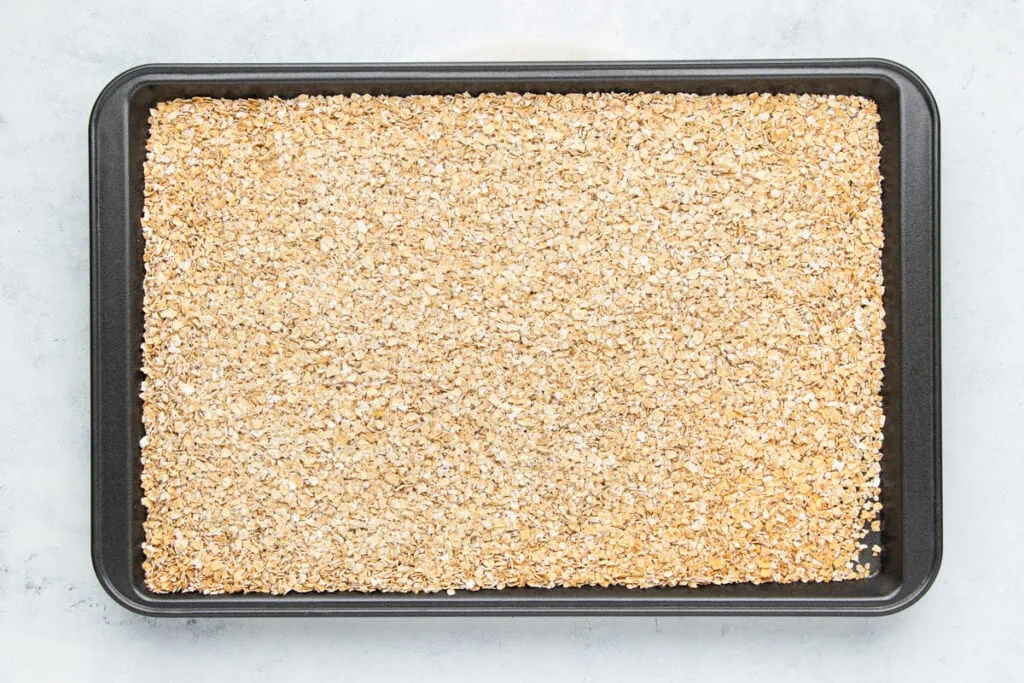
Add the toasted oats and all remaining ingredients to a large mixing bowl and stir well.
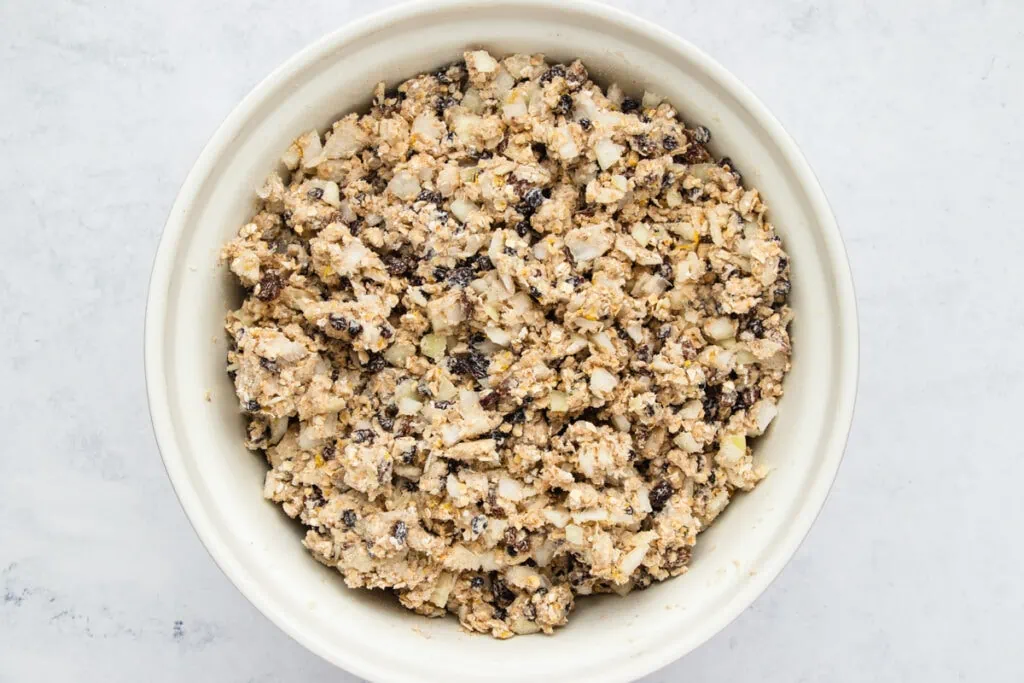
Add 1/3 cup to ½ cup water as needed – just enough to help the mixture come together so that when you take a handful and squeeze it holds its shape.
Take about 1/3 of the mixture and use your hands to roughly shape into a sausage approx. 7” long and 3” wide.
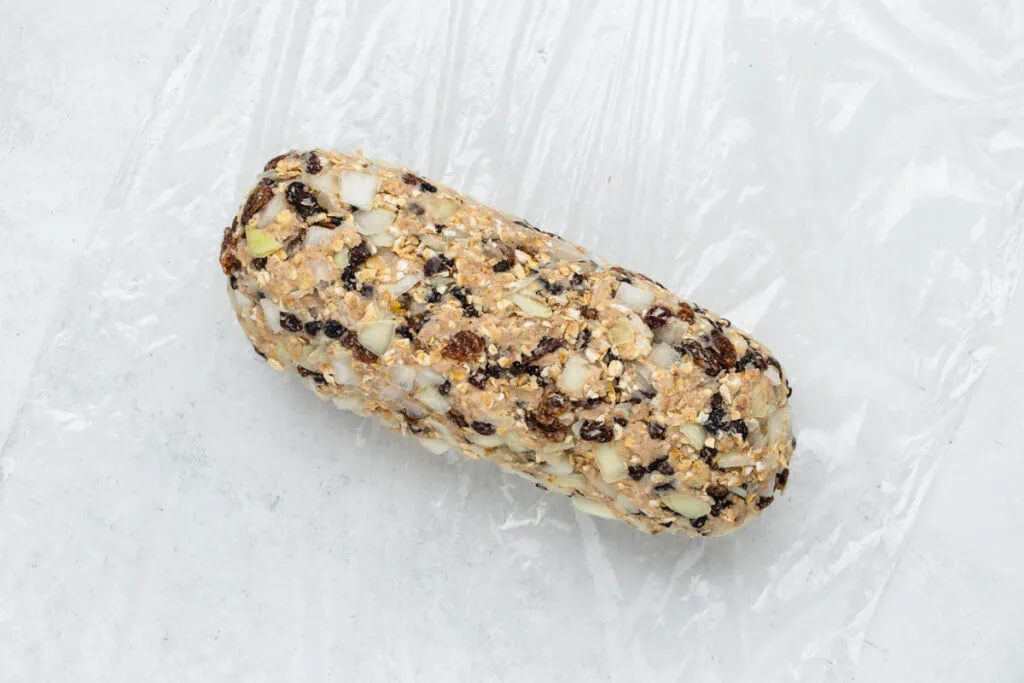
Wrap the sausage in cling film so it is completely covered.
Roll the sausage on a flat surface with two hands to help give it a nice even, rounded shape.
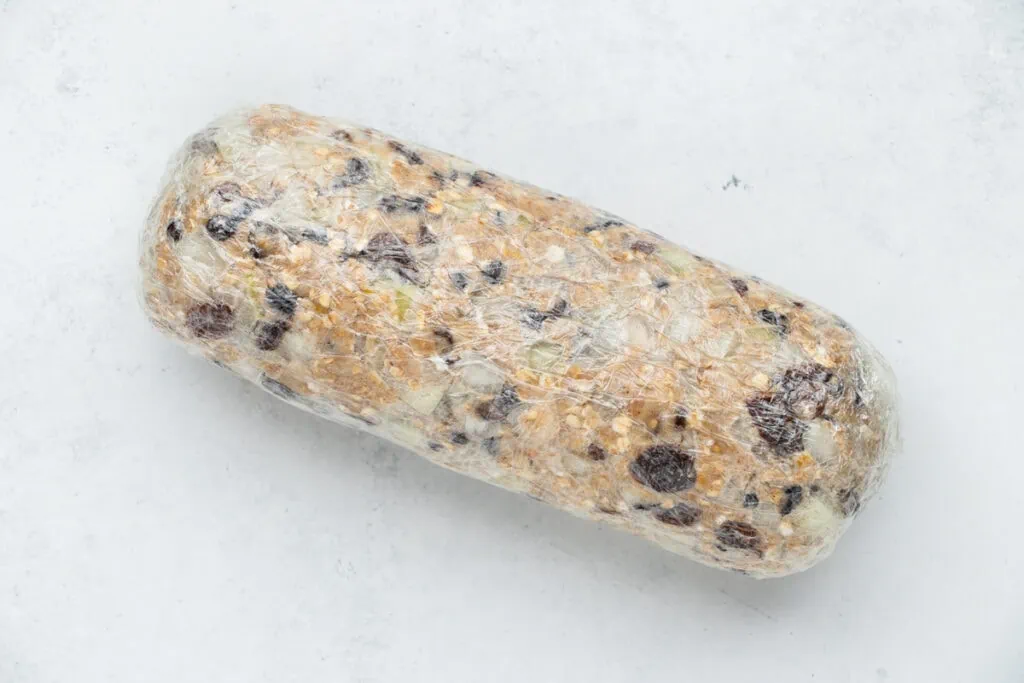
Repeat twice more with the remaining mixture. There should be enough to make 3 sausages.
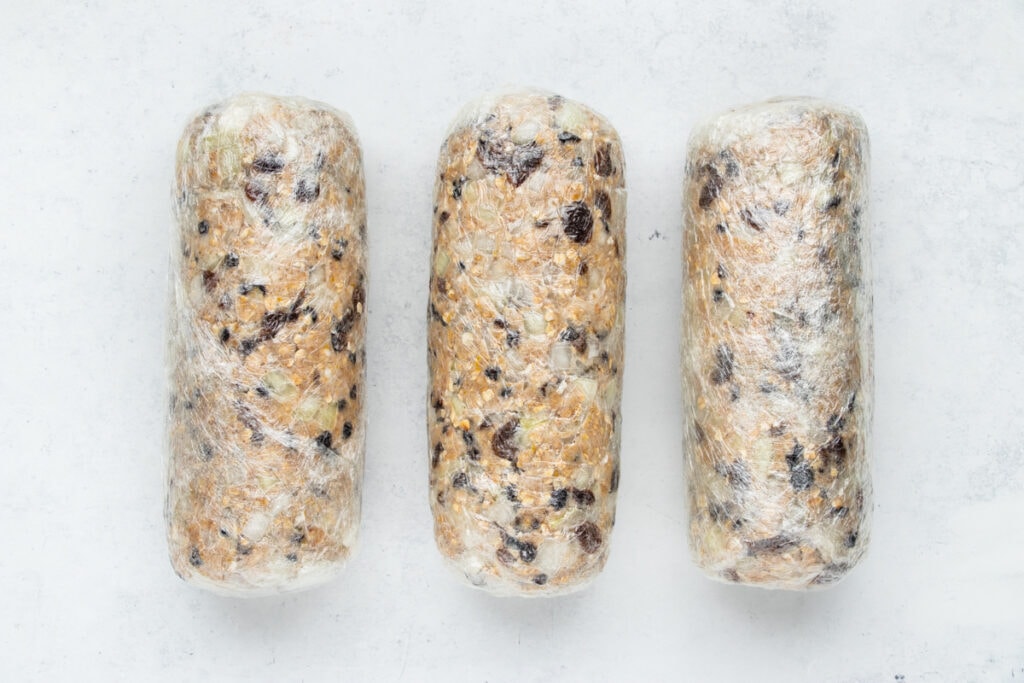
Freeze for 2 hours or until firm enough to slice but not soft so that it falls apart.
Unwrap and slice into rounds approx. ¾” thick.
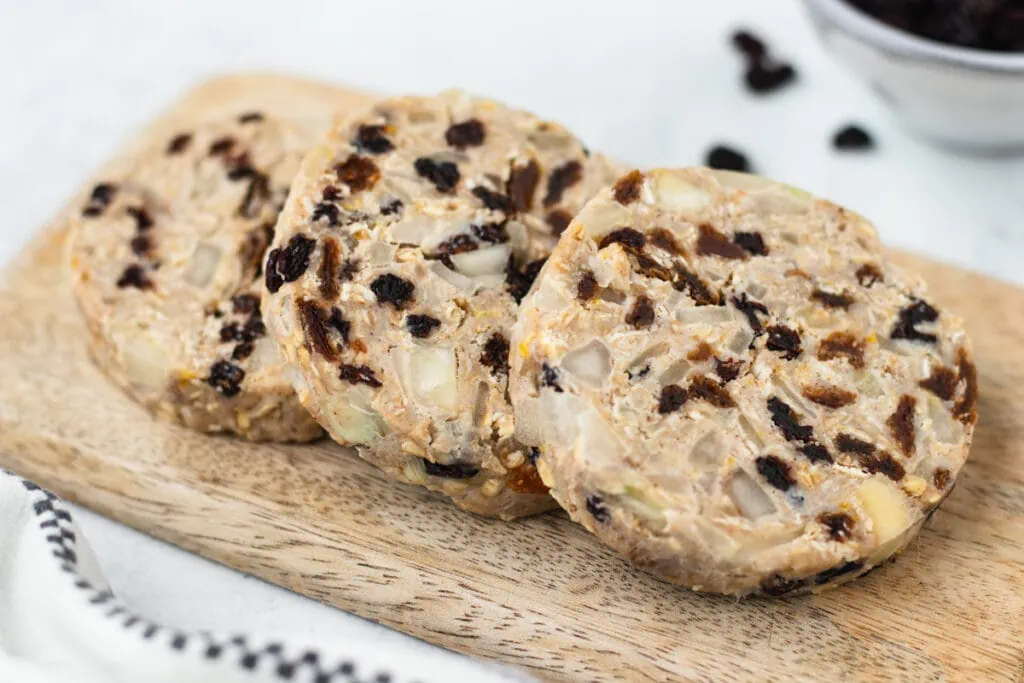
Heat approx. 3 tbsp oil in a frying pan on a medium/low setting. Add the fruit pudding slices and fry until browned and cooked through – about 4-5 minutes on each side. You don’t want the dried fruit to catch, so add extra oil if necessary.
Why do you freeze the Fruit Pudding before slicing it?
As we mentioned above, shop-bought Scottish Fruit Pudding comes in a sausage casing. This Scottish Fruit Pudding recipe enables you to make a homemade version without the need for sausage-making tools.
Some people just form the mixture into patties and fry, but we find they can sometimes fall apart that way. Another option is to use chefs’ rings as we use for our Haggis, Nepps & Tatties Stack, and while this works well, it can be a bit fiddly to get the mixture into them.
We think freezing and slicing, like our Lorne Sausage recipe, is the easiest and best option!
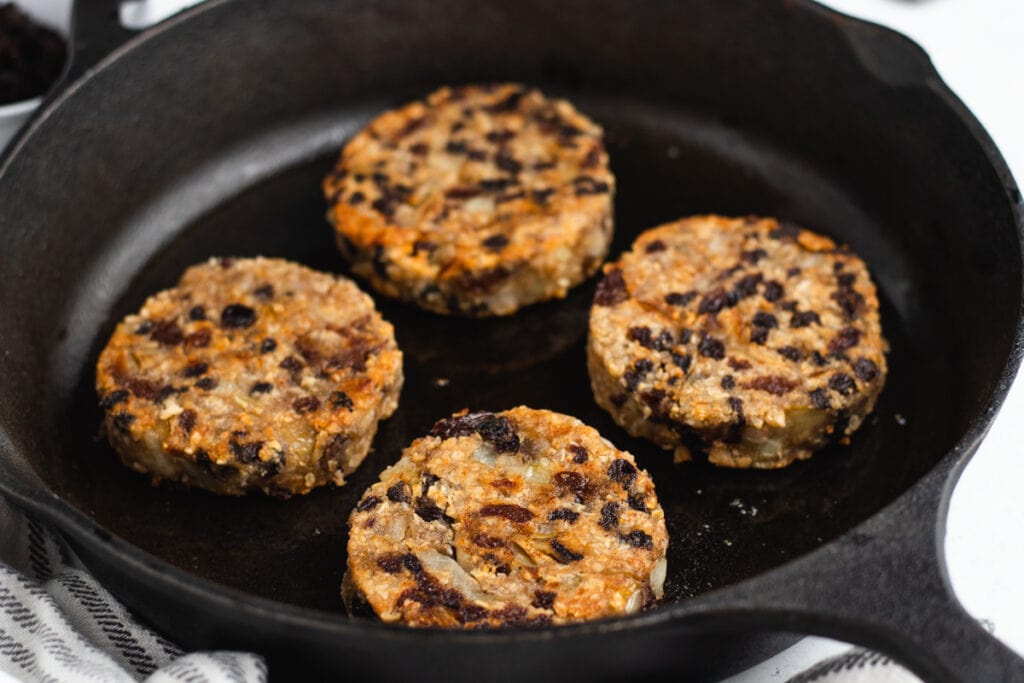
Can you freeze Scottish Fruit Pudding for later?
Fruit Pudding is suitable for freezing. We would recommend freezing it for the time needed for it to come together to slice (around 2 hours), as mentioned above and then slicing it.
You can then keep some in the fridge to be used within the next three days and put the other slices between pieces of baking paper to fully freeze for later.
When you want to cook a slice you can take it out and allow to thaw in the fridge overnight or just cook straight from frozen, adding a few minutes extra to the cooking time.

Can Scottish Fruit Pudding be Vegetarian?
Beef suet is the classic type of fat used in making Scottish Fruit Pudding, however, there is nothing stopping you from trying it out with vegetable suet instead.
Homemade Scottish Fruit Pudding Recipe
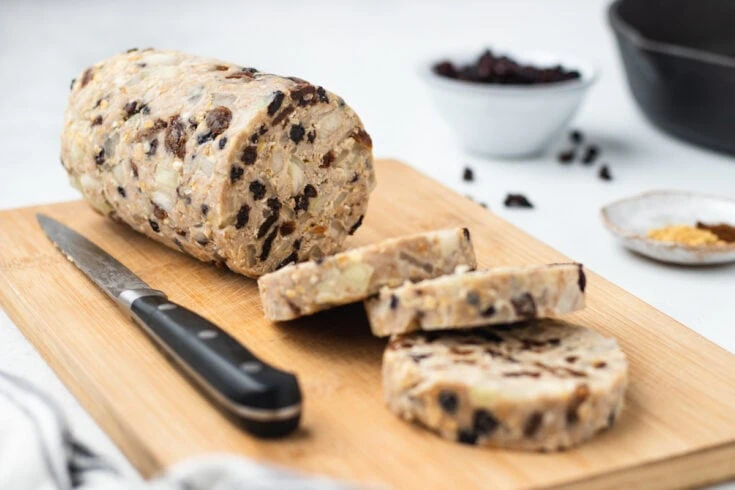
Scottish Fruit Pudding is a combination of oatmeal and beef suet, with dried fruit like raisins and currants, brown sugar, and spices like cinnamon. It's generally formed into a sausage shape and sliced for frying in butter. The result is both savoury and sweet!
Scottish Fruit Pudding is generally part of a classic Scottish Breakfast, and yet it seems to be disappearing from plates across the country as we don't see it as often when eating out, and generally only as a part of certain breakfast packs in some supermarkets.
We decided it was time to make our own homemade Scottish Fruit Pudding recipe, so you're not reliant on getting it from elsewhere.
Ingredients
- 400g/14oz beef suet
- 400g/14oz porridge oats (5 cups)
- 400g/14oz plain flour (3 1/3 cups)
- 1 tbsp brown sugar
- 3 large onions (finely chopped)
- 250g currants (1 ¼ cups)
- 250g sultanas (1 ¼ cups)
- 1 tbsp orange zest
- 1 tsp ground ginger
- 1 tsp cinnamon
- ½ tsp ground cloves
- 1 tsp allspice
- ½ tsp salt
Instructions
- Preheat the oven to 180C. Spread the oats out on a large baking tray and toast in the oven for 12 minutes.
- Add the toasted oats and all remaining ingredients to a large mixing bowl and stir well.
- Add 1/3 cup to ½ cup water as needed – just enough to help the mixture come together so that when you take a handful and squeeze it holds its shape.
- Take about 1/3 of the mixture and use your hands to roughly shape into a sausage approx. 7” long and 3” wide.
- Wrap the sausage in cling film so it is completely covered.
- Roll the sausage on a flat surface with two hands to help give it a nice even, rounded shape.
- Repeat twice more with the remaining mixture. There should be enough to make 3 sausages.
- Freeze for 2 hours or until it's firm enough to slice and not fall apart.
- Unwrap and slice into rounds approx. ¾” thick.
- Heat approx. 3 tbsp oil in a frying pan on a medium/low setting. Add the fruit pudding slices and fry until browned and cooked through – about 4-5 minutes on each side.
Nutrition Information:
Yield:
30Serving Size:
1Amount Per Serving: Calories: 159Total Fat: 4gSaturated Fat: 2gTrans Fat: 0gUnsaturated Fat: 2gCholesterol: 13mgSodium: 54mgCarbohydrates: 26gFiber: 2gSugar: 12gProtein: 6g
The above values are an indication only.
Other Scottish Breakfast Recipes to Try:
- What is a Full Scottish Breakfast? And How to Make The Best One!
- Easy Homemade Lorne Sausage Recipe
- The Perfect Scottish Morning Rolls Recipe
- How to Make Porridge
- The Easiest Cheese and Bacon Turnovers Recipe
Pin for Later!


I’m from Scotland, but live in Australia now. I have never heard of or had Scottish Pudding – I’m from Shettleson in Glasgow, so maybe that has something to do with it 🙂
It’s Fruit Pudding Maggie, often served with white pudding, or black pudding. Just another addition to a Scottish breakfast you find in some parts of Scotland.
Hi Maggie, it would definitely have been around in Shettleston – I’m originally from Bridgeton and I remember it. It’s amazing. Mainly available from butchers shops but occasionally found in 4 slice packs in some supermarkets. I’m so glad to have found this recipe and have just made my first batch – so easy. Can’t wait to fry it up .
I grew up in Ayrshire
, but moved back to Cornwall when I was young, and REALLY miss fruit pudding! I’ve tried several recipes, but none were quite right, I can’t wait to try this…I will report back! I think I’ll try using my burger press to make individual puddings. Thank you so much for the great recipes, I’ve done many of them.
You’re very welcome Julie! Let us know how they work out. – Phil
I made this today, haven’t cooked it yet but the mix smells perfect. Fruit pudding is my favourite thing in Scottish cooked breakfast (haggis and black pudding tie for second), so I am very excited to make it for the first time.
A few tips for anyone making this, as I think the recipe assumes a bit of cooking know-how to adjust when things aren’t looking quite right:
1) For dry climates, you may need more water, I needed over a cup. When it is done there will be no dry mix left in the bottom of the bowl, the mix will form little clumps, and the fruit will no longer appear dusty/white.
2) The volume of mix is very large (bigger than a normal Kitchenaid mixer bowl). If your bowl is too small, you may need to work in batches. I mixed the dry mix in one big bowl but divided it into three parts (one per sausage), to add water, form, and wrap each sausage.
3) Make sure you finely chop the onion (about 0.5 cm pieces), or the sausage will crack. Dicing this much onion is also time consuming. If using a food processor, don’t over-process into mush.
4) Type of oats matters. Not sure if it is supposed to be pinhead (steel cut), but I only had large flake. If using large flake, crush some of them a bit to help with binding. I crushed about 25%.
5) If the sausage forms big cracks when trying to roll, I suggest putting it back in the bowl with a little more water and trying again. I haven’t tested if the cracks are a problem, but I think a cracked roll it will fall apart when cooking. Most of the cracks were from little bits of dry mix or too much concentration of fruit in one place.
6) It took a lot longer than 10 mins prep time indicated. If this is the first time you are making the recipe, I would allow at least 30 mins. It took me over an hour because my onions were tiny and annoying to peel, and it took a few attempts to get well-formed sausages. At the end though, the rolls looked perfect! Should be much faster next time!
Thanks again for the recipe!!
Can you explain to this ignorant foreigner the different kinds of oats? Some recipes call for Scottish oats (which sounds like maybe oat flour?),c this one for porridge oats…
I am familiar with “old fashioned” rolled oats and the “quick cooking” alternative (not instant! I don’t know what those are but they are not the same!), “steel cut” oats (sometimes also called “Irish”), and I’m pretty sure I’ve seen “oat berries” (whole oats) in some fancy shops.
What should I be looking for for this recipe (fruit pudding) or for others like Clootie Dumpling?
We have a good explanation in our Porridge recipe, https://scottishscran.com/how-to-make-porridge/